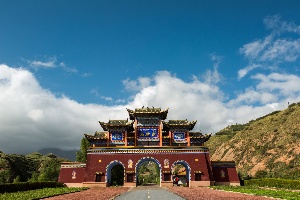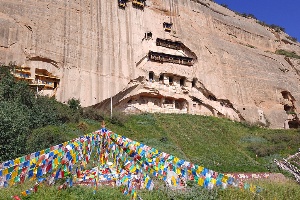 The Matis Temple
The Matis Temple
Mati Temple is located in the Yugu Autonomous County of Sunan, Gansu (the Yugu nationality is a special minority in Zhangye, Gansu); 65 kilometers north of the urban area of Zhangye City, it is a tourist area integrating grotto art, Qilian Mountain scenery and Yugu customs. The grotto consists of seven caves including Shengguo Temple, Puguang Temple, Thousand Buddha Caves, Golden Pagoda Temple, Upper, Middle and Lower Guanyin Caves. There are more than 70 cave niches, which were built in Beiliang. Horseshoe Temple is named after the legendary Tianma has horseshoe prints on drinking water here. The legendary horseshoe imprints exist in the horseshoe hall of Puguang Temple and become the treasure of the temple.
Chinese Name:马蹄寺
Location:Dadu Ma Township, Sunan County, Zhangye City
Ticket:73Rmb/pp
Opening Time:8:00-18:00
What to Visit in the Matis Temple
1.Thousand Buddha Cave
 The Matis Temple
The Matis Temple
The first thing you can pass through from the entrance of the gate is the Thousand-Buddha Caves. The Thousand-Buddha Caves have more than 500 cliff-hanging stupas and niches. The scale is huge. Today, hundreds of excavated from the cliffs next to the temple in the Yuan and Ming dynasties exist. A Buddhist niche, in these niches chiseled on the cliff, there were originally one to several Buddha statues or pagodas, so the "Thousand Buddha Cave" was named after it.
2.Thirty-three days grotto
The "Thirty-Three Days" grotto is excavated on the red sand rock wall of Puguang Temple. From the scenic spot to the north, along the winding road, to the white pagoda, you can see the "Thirty-Three Days" grotto from a distance. . Using a high-altitude vision to see the Thirty-Three Heavens Grottoes is unparalleled shock. Although it seems that it is not high on the cliff, it is designed like this, which is more steep and dangerous than the Thousand Buddha Cave.
3.Horseshoe Temple
Horseshoe Temple is the core of Horseshoe Temple, which is the source of the name of Horseshoe Temple. It is said that every day the sky is high and the sky is beautiful, the Tibetan hero King Gesar rode his own Tianma, passing by the Horseshoe Temple, King Gesar on horseback closed the ceremony, and the Tianma was deeply touched by the beautiful scenery of the Horseshoe Temple. I was convinced, so Tianma wanted to stay here to take a break and watch. It found a shady place, the current Horseshoe Hall. As soon as the horseshoes landed, King Gesar woke up from his horse. Reining on the reins, Tianmatian soared into the sky and flew away, but the horseshoe prints stayed here forever.
4.Tibetan Buddha Hall
After descending from the Horseshoe Hall, there is the Tibetan Buddha Hall. Located on the north side of the 33tian Grottoes, it is the largest grotto in the Horseshoe Temple and the largest single grotto in China. The structure of the cave is complex, which is a rare form in grotto art.
5.Shengguo Temple
Of course, in Mati Temple, there are still some places that have to be visited, such as Shengguo Temple. Shengguo Temple was built in the Ming Dynasty. After the completion of Shengguo Temple, when the imperial minister asked the emperor to give the temple the name, the imperial court won the victory of the southern military, and the emperor Longyan rejoiced and gave the name "Shengguo Temple." Emperor Qianlong of the Qing Dynasty gave the famous plaque, dragon robe and saddle of the Yuci Temple of the temple.
6.Palace of King Gesar
According to legend, King Gesar was the incarnation of Guru Padmasambhava, who served as an army throughout his life, promoting good and suppressing evil, advocating Buddhism, and spreading national culture. At the age of sixteen, he selected the king on horse racing and ascended to the throne, marrying Zhumu as his wife. As early as the tenth to the eleventh century, he won the title of lion king, and he is a proud hero of the Tibetan people. In the temple, there are 33 generals, including King Gesar, who led the Western Emperor Chagang, Jiacha, and other soldiers to fight in the north and south, uniting more than 150 tribes, large and small, to return the territory of Lingguo. A unified story.
7.Guanyin Cave
The upper, middle and lower Guanyin Caves are located 7 kilometers east of the temple, surrounded by bushes and forests, and the environment is very quiet. The three caves are built on three different rock peaks, named after the upper, middle and lower sides arranged in different directions. . The central pillars and walls of the upper, middle and lower Guanyin Caves still contain some early statues and murals. Some are very complete and eye-catching, especially the murals of the "Four Gods Playing in the Water". It is rare to see these two caves now. It is supported and protected by monks.
Tips
1. To enter the scenic spot with a ticket, please observe public morals, respect the customs of local ethnic minorities, and consciously maintain normal tourist order.
2. In order to ensure the safety of cultural relics and forest fire safety, please do not bring flammable and explosive materials into the scenic spot.
3. In case of parties with "warning signs", please consciously follow the prompts on the "warning signs" to avoid potential safety hazards.
4. It is strictly forbidden to scribble, collect flowers and make wood when visiting.
5. Please take good care of public health, do not throw debris, and it is strictly forbidden to urinate and defecate anywhere in the scenic area.
6. The Mati Temple tourist area is a high-altitude area, and people who are frail, old and infirm, with high blood pressure, coronary heart disease, and heart disease should prepare common medicines.
7. Accidents or emergencies occur during the tour; please contact the nearby staff of the Security Section of the scenic spot in time to get help in time.
8. In the densely virgin forest area of the Horseti Temple tourist attraction, fireworks are strictly prohibited in the scenic area, and tourists are not allowed to litter cigarette butts at will.



































